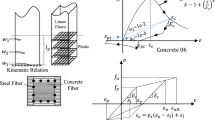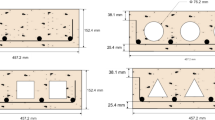Abstract
Coupling beams between shear walls are one of the key elements for energy dissipation in tall buildings. A representative mathematical model of coupling beam should represent flexure, shear and interface slip/extension mechanisms simultaneously. This goal can be achieved by using either detailed finite element models or by using macro models. This paper presents a review of various macro model alternatives for diagonally reinforced coupling beams in the literature. Three distinct methods have been reviewed in terms of their modeling techniques, the cyclic response overlap and the amount of cumulative plastic energy dissipated based on the results of previously performed tests. Through an analytical study, adequately accurate results can be captured by using macro models, although they are simpler in practice compared to sophisticated micro models. This study shows that, by modifying ultimate shear capacities where concrete material between diagonal bundles is adequately confined, it is possible to capture a more realistic result and a better approximation to the actual responses. It is also concluded that a simpler numerical model for diagonally reinforced coupling beams can be achieved by introducing linear part of slip/extension behavior into elastic part of the beam. It is observed, as a result of this study, that the ratio of effective stiffness to that of the gross cross-sectional one ranges from 0.04 to 0.14 in diagonally reinforced coupling beams depending on the aspect ratio and the beam strength parameters.
















Similar content being viewed by others

References
ACI Committee 318 (1999) Building code requirements for structural concrete (ACI 318-99) and commentary (318R-99R). American Concrete Institute, Farmington Hills, MI
ACI Committee 318 (2011) Building code requirements for structural concrete (ACI 318-11) and commentary (318R-11R). American Concrete Institute, Farmington Hills, MI
Alsiwat JM, Saatcioglu M (1992) Reinforcement anchorage slip under monotonic loading. J Struct Eng ASCE 118(9):2421–2438
ASCE/SEI 41-06 (2007) Seismic rehabilitation of existing buildings. American Society of Civil Engineers, Reston, VA
ASCE/SEI 41-13 (2014) Seismic evaluation and rehabilitation of existing buildings. American Society of Civil Engineers, Reston, VA
Barbachyn S, Kurama Y, Novak LC (2012) Analytical evaluation of diagonally reinforced concrete coupling beams under lateral loads. ACI Struct J 109(4):497–508
Barney GB, Shiu KN, Rabbat BG, Fiarato AE, Russel HG, Corley WG (1980) Behavior of coupling beams under load reversals. Bulletin RD068.01B, Portland Cement
Bower OJ, Rassati GA (2008) Axial restraint in diagonally reinforced coupling beams: an analytical investigation. Structures 2008: Crossing Borders, ASCE
Brena S, Ruiz MF, Kostic N, Muttoni A (2009) Modeling techniques to capture the backbone envelope behavior of coupling beams subjected to seismic loading. Studies and researches, vol 29, graduate school in concrete structures—Fratelli Pesenti, Politechnico di Milano, Italy
D’Ambrisi A, Filippou F (1999) Modeling of cyclic shear behavior in RC members. ASCE J Struct Eng 125(10):1143–1150
Fortney P (2005) The next generation of coupling beams. PhD Dissertation, University of Cincinnati, Cincinnati, OH
Galano L, Vignoli A (2000) Seismic behavior of short coupling beams with different reinforcement layouts. ACI Struct J 97(6):876–885
Harries KA, Gong B, Shahrooz BM (2000) Behavior and design of reinforced concrete. Steel and steel-concrete coupling beams. Earthquake Spectra, EERI
Hindi R, Hassan M (2004) Shear capacity of diagonally reinforced coupling beams. Eng Struct 26:1437–1446
Hindi R, Hassan M (2007) Simplified trilinear behavior of diagonally reinforced coupling beams. ACI Struct J 104(2):199–206
Jang S, Hong S (2004) The shear strength of RC coupling beams with plasitic hinges using strut-and-tie model. In: 13th World conference on earthquake engineering, No. 1480, 2004, Vancouver, Canada
Kwan AKH, Zhao ZZ (2001) Testing of coupling beams with equal end rotations maintained and local joint deformation allowed. Struct Build 152(1):67–78
Lu X, Chen Y (2005) Modeling of coupled shear walls and its experimental verification. ASCE J Struct Eng 131(1):75–84
Mohr D, Lehman D, Lowes L (2007) Performance based design and nonlinear modeling of coupled shear walls and coupling beams. In: 2007 Structures congress: New Horizons and Better Practices, ASCE
Naish D, Fry A, Klemencic R, Wallace J (2013a) Reinforced concrete coupling beams-Part I: testing. ACI Struct J 110(6):1057–1066
Naish D, Fry A, Klemencic R, Wallace J (2013b) Reinforced concrete coupling beams-part II: modeling. ACI Struct J 110(6):1067–1076
OpenSees (2013) Open system for earthquake engineering simulation. Pacific Earthquake Engineering Research Center, University of California, Berkeley, CA
Orakcal K, Massone LM, Wallace JW (2006) Analytical modeling of reinforced concrete walls for predicting flexural and coupled-shear-flexural responses, PEER Report 2006/07. University of California, Berkeley, CA
Paulay T, Binney JR (1974) Diagonally reinforced coupling beams of shear walls. Shear in reinforced concrete, SP-42. American Concrete Institute, Farmington Hills, MI, p 579
Scott MH, Gregory L Fenves (2006) Plastic hinge integration methods for forced-based beam-column elements. ASCE J Struct Eng 132(2):244–252
Tassios TP, Moretti M, Bezas A (1996) On the coupling behavior and ductility of reinforced concrete coupling beams of shear walls. ACI Struct J 93(6):711–720
Wallace JW (2010) Performance-based design of tall reinforced concrete core wall buildings. In: Earthquake engineering in Europe, geotechnical, geological and earthquake engineering, vol 17. Springer, Berlin, pp 279–307
Xiao Y, Esmaeily-Ghasemabadi A, Wu H (1999) High-strength concrete beams subjected to cyclic shear. ACI Struct J 96(3):392–399
Xtract (2007) Cross section analysis program for structural engineers. TRC, Rancho Cordova, CA
Zhao ZZ, Kwan AKH, He XG (2004) Nonlinear finite element analysis of deep reinforced concrete coupling beams. Eng Struct 26(10):822–826
Acknowledgments
The principal author is a Ph.D. candidate in the Structural Engineering graduate program at Istanbul Technical University, Istanbul, Turkey. This research was funded by Istanbul Technical University Scientific Research Project Coordination Department (BAP). Their generous support is gratefully appreciated. The authors would also like to acknowledge Arup and its engineers for providing their sources and sharing their experiences. Their invaluable knowledge, expert guidance and encouragement allowed this work to be completed. The authors are greatly thankful to Dr. Eleni Smyrou for providing technical contribution to this article. The authors would finally like to thank to the anonymous reviewers who contributed in improving the paper largely during the review process.
Author information
Authors and Affiliations
Corresponding author
Rights and permissions
About this article
Cite this article
Toprak, A.E., Bal, İ.E. & Gülay, F.G. Review on the macro-modeling alternatives and a proposal for modeling coupling beams in tall buildings. Bull Earthquake Eng 13, 2309–2326 (2015). https://doi.org/10.1007/s10518-014-9720-z
Received:
Accepted:
Published:
Issue Date:
DOI: https://doi.org/10.1007/s10518-014-9720-z



